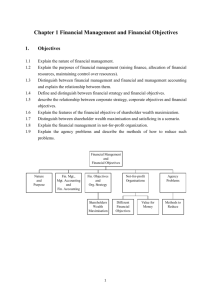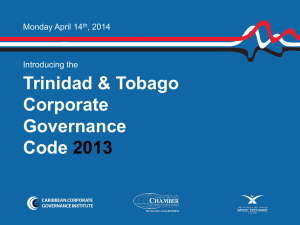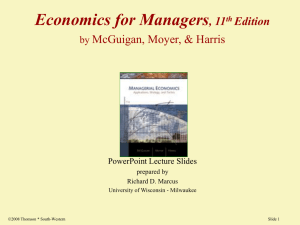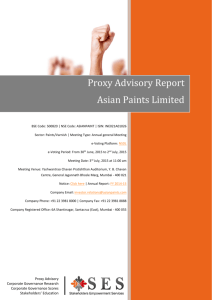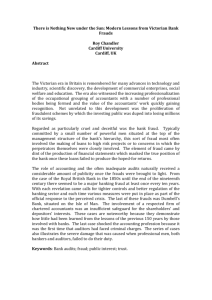Managing Finance & Budgets
advertisement
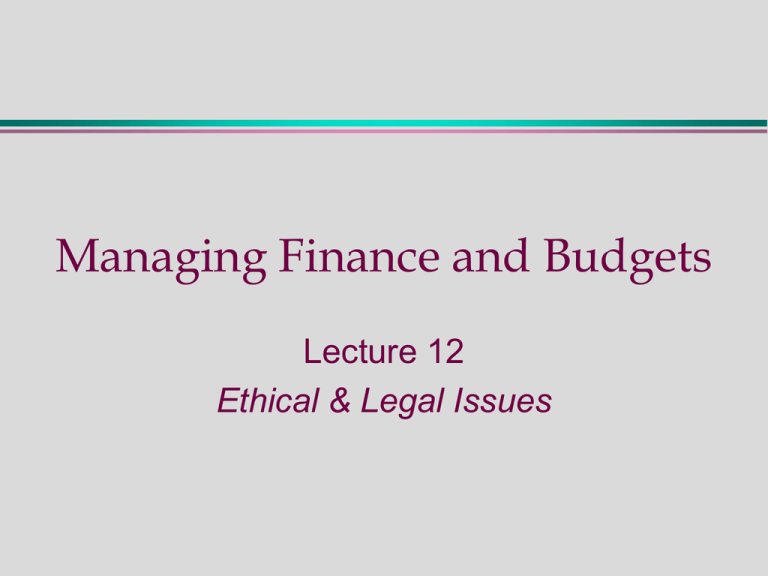
Managing Finance and Budgets Lecture 12 Ethical & Legal Issues Session 12 – Ethical & Legal Issues KEY CONCEPTS Accounting Rules Auditor responsibilities Creative Accounting Whistle blowing Corporate Social Reporting Accounting for the environment Ethical & Legal Issues A B C Accounting: Regulatory Frameworks Creative Accounting Ethical Accounting Section A: Accounting: Legal and Regulatory Frameworks Accounting Rules There are three distinct Sources of Accounting Rules for PLCs: 1. Company Law 2. Accounting Standards 3. Stock Exchange Rules Sources of accounting regulations for a UK limited company listed on the Stock Exchange Company law External accounting rules Stock exchange rules Accounting standards Company Law Company Law as embodied in the Companies Acts 1985 & 1989 requires that Directors are responsible and accountable for their actions in respect of their management of the company’s assets: 1. To maintain appropriate accounting records 2. To prepare an annual profit & loss account, a balance sheet that shows a true and fair* view of accounts as well as a Directors’ Report and to make these available to all shareholders and the public at large. *The term “true & fair” is not clearly defined in the legislation Accounting Standards Accounting Standards or Financial Reporting Standards are the rules established by the Accounting profession that should be followed in the preparation of the annual accounts of companies. These rules are not legally binding, however they do define more clearly what is meant by “true and fair” Different standards are concerned with: • • • • • • • how an item should be treated presenting information disclosing information valuing assets and measuring profits. Stock Exchange Rules • • These rules extend the accounting rules for those companies listed on the Stock Exchange. These rules require: • Summarised interim (I.e. half-yearly) accounts in addition to the annual accounts. • A geographical analysis of turnover • Details of shareholdings in other companies where the investment is greater than 20% The Audit Process • • • • Shareholders are required to elect a qualified independent person to act as Auditor. The role of this person (or firm) is to report on whether or not the company’s financial statements are “true and fair”, and whether they comply with the regulatory frameworks. In order to do this, auditors must not only scrutinise the statements, but the evidence on which the statements are based. Their report is sent to the Registrar of Companies. Auditors • • • • Shareholders elect the directors to act on their behalf. The directors account for the financial performance and financial position of the company. The shareholders elect an auditor to check that the statements made by directors are accurate The auditors report to the shareholders. The relationship between the shareholders, the directors and the auditors Directors review elect Auditors account elect Shareholders Section B: Creative Accounting Deviant Accounting Practice The Collapse of ENRON, the investigations into Xerox in 2002 and other high-profile events has raised questions about the effectiveness of the Regulatory Frameworks. The accounting methods used by Anderson Associates for example seem to have successfully persuaded the corporate community that certain companies were profitable, when in reality those companies were in deficit. Many of the accounting practices used, while not exactly illegal, do not abide by the spirit of the regulations. They are sometimes euphemistically termed “Creative Accounting” Creative Accounting “ Every company in the country is fiddling its profits. Every set of published accounts is based on books which have been gently cooked or completely roasted.” Ian Griffiths – Creative Accounting (1985) “Much of the apparent growth in profits which had occurred in the 1980s was the result of accounting sleight of hand rather than genuine economic growth.” Terry Smith –Accounting for Growth (1992) Creative Accounting “ The accounting process consists of dealing with many matters of judgement and of resolving conflicts between competing approaches to the presentation of results of financial events and transactions. This flexibility provides opportunities for manipulation, deceit and misrepresentation” Michael Jameson A Practical Guide to Creative Accounting (1988) Creative Accounting - Methods Selection of accounting policies Using judgement to give an optimistic or pessimistic view as required Using artificial transactions to manipulate balance sheet entries or to move profits between periods Timing transactions to move profits to required time frame Creative Accounting - Example REAL Balance Sheet: Fixed Assets £25m Current Assets Stock £10m Debtors £5m Current Liabilities -£10m LT Liabilities -£15m £15m Capital £20m LOSS -£5m £15m Old stock revalued upwards by £5m CREATIVE Balance Sheet: Fixed Assets £25m Current Assets Stock £15m Debtors £5m Current Liabilities -£10m LT Liabilities -£10m £25m Capital £20m PROFITS £5m £25m £5m Loan taken out in final part of year; 1st payment not yet due. Creative Accounting - Motivation Hide volatility of profits thereby reducing perceived risk in organisation Delay tax burden Increase personal rewards where linked to profits Improve perceived wealth of company Deceive stakeholders Move blame for poor results onto predecessor (or successor) Monitoring Given the existence of a multiplicity of frameworks, one question which needs to be asked is: “How is it that these anomalies are not picked up during the auditing process”? One answer to this may be that in many cases the firm appointed to do the auditing has close links with the firm which does the accounting. The Role of Auditors Role conflict – should be objective but are also a supplier Often unable to detect fraud Frequently reluctant to report fraud Suffer from lack of accountability and independence Insist on self-regulation Subject to competitive pressures Auditors’ unprofessional behaviour Allocating insufficient time due to budget restraints Accepting weak client explanations Focusing on completion deadlines instead of thoroughness Excluding awkward items from samples Accepting doubtful evidence from clients Conflict of interests How is Deviant Practice Uncovered? If the movements of money are a one-off, simple shift from one reporting period to another, this may never be detected. This is the primary motivation. However, invariably when this has been done once, it needs to be repeated. This creates a downward spiral from which it is difficult to recover. In many cases, it is employees who are required to construct or falsify records who alert the press or authorities . Such people are called “Whistle blowers” Whistle blowing Financial management provides privileged view of the organisation’s dealings Deviant managerial procedures may become apparent E.g. Use of company assets for personal use Hiding income from tax or vat authorities Breaking of reporting regulations Over-valuing (or under-valuing) of stock Damages for whistle blower could be loss of reputation; personal liability; dismissal Section C: Ethical Accounting Practice Corporate Social Reporting Organisations ought to be answerable to stakeholders Currently, regulations only relate to financial reporting Other information is only given selectively or for PR Suggested five elements of CSR: Environmental reporting Fair business practices (e.g. to employees/suppliers) Community involvement Products – safety and impact Social policy Accounting for the environment Adopting environmental policies Carrying out environmental audits Controlling energy costs and waste Packaging and recycling Life cycle analysis Ethical borrowing and investment Social audits Incorporating sustainability in organisational priorities Managing Finance and Budgets EVALUATION There is a short questionnaire to fill in on the module. The purpose behind the questionnaire is to examine correlations between your academic experience on the module and other factors. These factors may include gender, country of origin, previous experience of finances, time allocated to study, etc. I aim to make changes to the module for next year. This will allow me to focus energy precisely where it is needed. Managing Finance and Budgets THE END! GOOD BYE, THANKS AND GOOD LUCK MAY SEE YOU NEXT TERM for SPREADSHEETS IN FINANCE & FORECASTING


